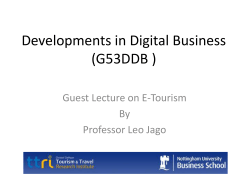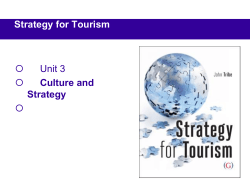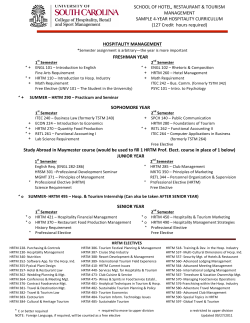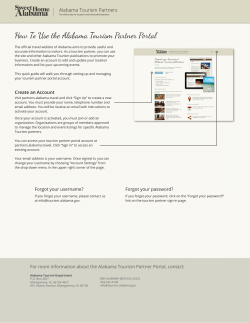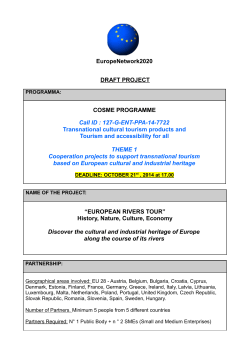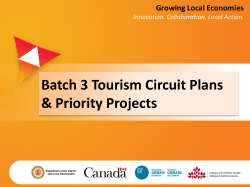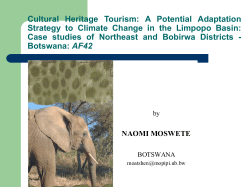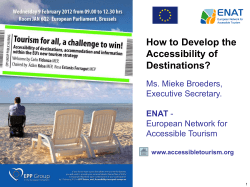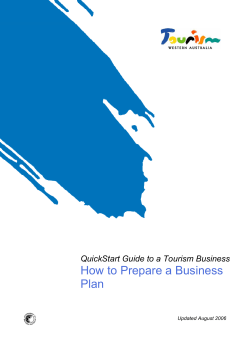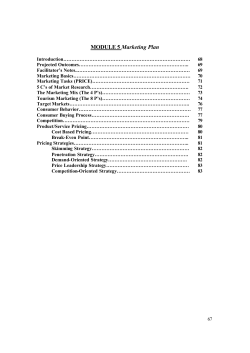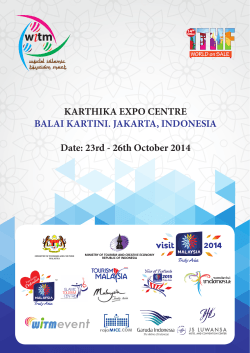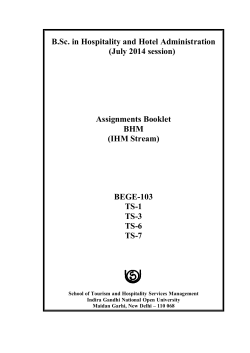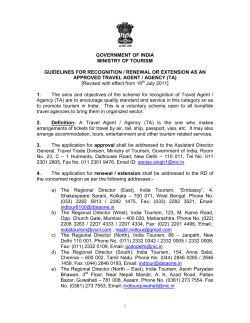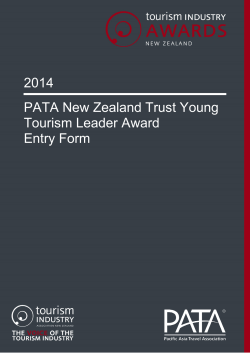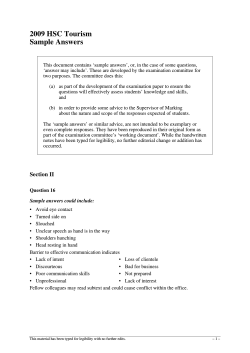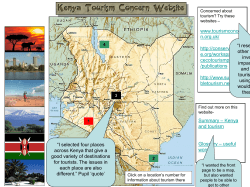
Why in the World [
[ Special Feature ] Why in the World Do Patients Travel for Medical Care? by Michael D Horowitz, MD, MBA Founder & Principal, Medical Insights International The global medical travel industry has been estimated to currently generate revenue up to US$60 billion per year, with 20% annual growth. Another valuation suggests that the industry may be somewhat smaller, with growth to US$40 billion projected by 2010. In either case, it is clear that many people travel for medical care. This article explores the reasons why people journey to a variety of global destinations for medical services. The term “medical travel” includes two patterns wherein people 24 ■ Volume 12 > Number 7 > 2008 receive medical care outside their own communities: the traditional international medical care model and the medical tourism model. In the 20th century, rapid scientific discovery and medical progress drove a proliferation of healthcare facilities in Europe and the United States, providing the benefits of the latest clinical techniques and technological innovations to the citizens of these countries. At the same time, patients in less developed areas of the world continued to have poor access to medical services. People with the necessary resources journeyed to major referral centers to have medical care that was unavailable in their own countries. Many wellknown hospitals in North America and Europe continue to provide services to a large number of patients from all areas of the world in the traditional model of medical travel. More recently, medical tourism has evolved as a phenomenon wherein patients from industrialized nations seek healthcare at advanced medical facilities in less developed countries, bypassing services offered in their own communities. The medical travel marketplace has been transformed from a one-way pipeline towards industrialized nations into a two-way highway with patients now traveling in both directions. Although there are some similarities between the traditional pattern of international medical travel and the medical tourism model, there are also meaningful differences, as described and analyzed in a previous publication.1 The factor that most differentiates the two models is the availability of resources to patients. Financial resources give traditional international patients access to medical facilities of their choice throughout the world. Conversely, the absence of some resource drives patients to pursue medical tourism. Medical travel is driven and shaped by the complex interactions of myriad medical, economic, social, and political forces. Nevertheless, the reasons why patients choose to travel thousands of miles, frequently crossing national borders, can be classified as follows: • Affordability of care • Timeliness of care • Availability of care • Patient preference for specific providers • Patient preference for specific geographic locations. www.asiabiotech.com [ Special Feature ] Affordability of Care Affordability is the principal driver in the medical tourism model, particularly for patients from the US and other industrialized nations that do not have national health plans that pay for healthcare. Patients in the medical tourism model would almost certainly prefer to have major surgery in their hometown hospital or regional referral center if that was a reasonably affordable option for them. Medical tourists balance their health needs against other considerations, and the opportunity to conserve limited financial resources and protect the equity in their home goes a long way towards assuaging doubts. These patients feel forced to accept uncertainties about quality of care and accommodations, as well as the inconvenience of travel, in order to obtain services at prices they can more comfortably afford. An analysis of the cost of hip replacement surgery showed overall financial savings of approximately 75% for American patients who choose to undergo operation in either Costa Rica or India.2 www.asiabiotech.com Patients traveling from the US generally fit one of two profiles. The first is a middle class adult who requires elective surgical care but has inadequate or absent health insurance coverage. The other group consists of patients who desire procedures such as cosmetic surgery, dental reconstruction, fertility treatment and gender reassignment procedures. In both groups, resources are insufficient for them to comfortably buy care in their local market, but adequate for them to obtain care in a low cost offshore medical center. Because government sponsored health systems generally do not pay for cosmetic surgery and similar procedures, patients from countries with such programs who want these services pursue medical tourism for the same reasons as patients from the US. Timeliness of Care For patients from Canada, Britain and other countries where a governmental healthcare system controls access to services, the primary motivation to bypass the local medical system is the desire to have timely treatment, circumventing delays associated with long waiting lists. It is important to recognize that once a patient decides to abandon the local healthcare system, further issues come into play in determining exactly where to travel for care. Is the subsequent driver in selecting a destination for care its proximity, reputation or affordability? For example, consider the case of a middle-age plumber from Vancouver, British Columbia, Canada who requires hip replacement or resurfacing for severe arthritis of his hip joint. This man finds himself increasingly unable to pursue his livelihood. He is concerned that he will become unemployed (or lose his business) if he waits for his position in the queue, likely more than 20 weeks. He is aware that he can “buy” hip surgery by driving two and a half hours to Seattle, Washington, USA — as long as he can afford this option. Indeed, if cost is not an issue for him he could arrange care at virtually any medical center in the world within a few days. However, if the price of surgery is important, the driver becomes affordability of care and, like the patients in the previous section, he must look to medical facilities where he can get the care he seeks at the lowest possible cost. Availability of Care In both the traditional international medical care model and the medical tourism model, patients travel to offshore medical centers to have procedures that are not available in their own countries. In the former situation, a patient has ample or abundant resources to travel wherever he or she may need or want. An example of this is a wealthy person living in a developing nation who needs medical care that simply is not available locally because of absent or Volume 12 > Number 7 > 2008 ■ 25 [ Special Feature ] inadequate facilities and/or expertise. The availability of resources makes it possible for this person to travel to any of a number of suitable medical destinations. In the medical tourism model, medical facilities and professional expertise may be available locally, however some social, regulatory or legal barriers make it impossible for a patient to receive the care they need or desire in their own community. An example of this is the patchwork of legal restrictions related to assisted reproductive technology. Women may travel from or to specific countries to avoid or benefit from laws regulating payment for donor eggs, use of preimplantation genetic diagnostics, implantation of prescribed numbers of embryos, and selective reduction of fetuses in multiple pregnancies. Another example relates to investigational techniques such as stem cell therapy. In many industrialized countries stem cell therapy may be accessible only by participation in clinical trials, however, this potentially beneficial intervention is more readily available in the medical tourism marketplace. Finally, the availability of donor organs for transplantation is a compelling reason for medical travel, particularly for patients from countries where social and legal restrictions, as well as very long waiting lists, provide little hope of ever receiving a donor organ. Patient Preference for Specific Providers A patient’s desire to have care by a specific physician or at certain medical facility is an important driver of medical travel. This motivation is seen primarily in the traditional model where the patient and family have the resources to pursue 26 ■ Volume 12 > Number 7 > 2008 preference. Recall that in the medical tourism model, the absence of resources drives the need for travel, thus reducing the patient’s ability to pursue “preference” over other considerations such as affordability. Patient preference for certain providers occurs in two discrete forms. In the first, a patient travels to a specific provider based on that provider’s reputation as being “the best.” Indeed, there may be objective evidence that this provider actually has better treatment outcomes than other providers. In many cases, the patient or family member simply believes that a certain facility or physician is “the best around” despite the absence of specific data to substantiate that claim. Finally, a patient may seek care from a specific doctor at a certain medical center based on the referral of a physician who is personally www.asiabiotech.com [ Special Feature ] knowledgeable about that facility, perhaps having trained there in the past or consequent to prior patient referral. This pattern of preference driving patients to specific high-end providers has been referred to as “Premium Healthcare.”3 In the second form of patient preference for a specific provider, a patient bases their decision on prior experience and existing relationships. An example of this is a patient who developed healthcare relationships with certain providers and facilities during prior medical encounters. Perhaps this patient lived in the particular geographic location and had a health problem requiring prolonged and/or complex treatment. It is understandable that this patient would want to return to “their doctor” or hospital for follow-up evaluation and subsequent therapy, as needed. The reason for medical travel in this situation is quite different from the others described in that, based principally on personal experience and relationships, it is unlikely to be altered by external forces, such as marketing by other providers. The long-distance relationship is secure as long as the patient continues to have the necessary resources to travel to this preferred provider. Patient Preference for Specific Geographic Destinations Some patients choose to have medical care abroad because of the opportunity to travel to exotic locations and to recover/vacation in luxurious surroundings. For people traveling abroad for general health evaluations, routine diagnostic studies, and limited surgical or dental procedures, the pleasurable non-medical aspects of the trip may be highly valued. Patients pursuing dental reconstruction, www.asiabiotech.com cosmetic surgery and correction of visual refraction certainly would be interested in recuperation in a comfortable environment where their needs are addressed promptly and courteously. Perhaps, some of these patients may even be able to enjoy limited tourism activities. Although some medical tourism agents and travel professionals may promote sightseeing and recreational endeavors, as the seriousness of the medical circumstances increases the importance of the tourism activities rapidly diminishes. A patient who travels to a distant country for affordable major surgery for a lifethreatening condition is not likely to be concerned about visiting the local tourist attractions. In addition, patients choose certain faraway destinations for care because they have greater confidence that their privacy and confidentiality will be protected. This is a particularly important consideration for patients undergoing sex change procedures, cosmetic surgery, and alcohol or drug rehabilitation. Also, as discussed above, the social norms, regulations and laws of a specific destination may have substantial impact on the availability of certain medical procedures. The drivers of medical travel are summarized in the Table. It is important to recognize that the reasons that an individual patient pursues international medical travel are complex. The drivers listed are interrelated and dynamic. Changes in medical knowledge and technology, local and international political events, and global macroeconomics all impact the international medical travel marketplace. Accordingly, the benefits and burdens of medical travel are perpetually changing and evolving. International medical travel will likely have a substantial effect on the availability and delivery of healthcare services in developing countries as well as industrialized nations. Indeed, the healthcare system and medical community will be transformed as consumers increasingly recognize that their purchasing options transcend national borders. n References 1. Horowitz MD, Rosensweig JA. Medical tourism vs. traditional international medical travel: a tale of two models. International Medical Travel Journal 3: 30–33 (February 2008). https://www.imtjonline. com/zine/features/medical-tourismvs-traditional-international-medicaltravel-a-tale-of-two-models 2. Horowitz MD. Financial savings in medical tourism. Medical Tourism Magazine 1: 14–15 (December 2007). http://www.medicaltravelauthority. com/Medical-Tourism-MagazineIssue-1.pdf 3. Yap JCH. The Singapore Medicine story. Asia Pacific Biotech News 11: 1262–1270 (15 October 2007) Contact Details: Dr Michael D Horowitz Founder & Principal, Medical Insights International Address:PO Box 639, Lebanon GA 30146, USA Email: michael_horowitz@mac.com URL: www.medicalinsightsinternational.com Volume 12 > Number 7 > 2008 ■ 27 [ Special Feature ] TABLE THE REASONS THAT PATIENTS TRAVEL FOR MEDICAL CARE 1. Affordability of Care l Patients with no insurance / inadequate insurance l Plastic and cosmetic surgery l Cosmetic dentistry / extensive dental reconstruction l Procedures for the treatment of obesity and subsequent body contouring l Gender reassignment procedures l Infertility treatment 2. Timeliness of Care l Patients from countries with governmental health services and long waiting lists l Decisions based on timeliness demand additional decisions based on other drivers 3. Availability of Care l Appropriate facilities and expertise not available locally l Social, regulatory and/or legal barriers preclude desired procedures locally – In vitro fertilization utilizing eggs from paid donors, preimplantation genetic diagnosis, selective reduction of fetuses – Stem cell therapy – Organ transplantation 4. Patient Preference for Specific Provider l Reputation of provider or physician referral – “The best available” – “Premium Healthcare” l Patient has prior experience and existing relationship with provider 5. Patient Preference for Specific Destination l Recovery, vacation and tourism – Luxurious accommodations and attentive service – Desirable vacation destinations l Privacy and Confidentiality – Cosmetic surgery, gender reassignment, and alcohol or drug rehabilitation Biography Dr Horowitz, MD, MBA, is Founder and Principal of Medical Insights International, a firm devoted to researching and analyzing medical tourism, and providing valuable information to parties involved or interested in this industry. Dr Horowitz has a strong interest in the marketplace dynamics and macroeconomic underpinnings of medical tourism. In addition, he has a deep understanding of the issues of quality of care, patient safety and accreditation. A graduate of the University of Miami School of Medicine, Dr Horowitz practiced Cardiothoracic Surgery for more than 15 years. He has an MBA from Goizueta Business School of Emory University. 28 ■ Volume 12 > Number 7 > 2008 www.asiabiotech.com
© Copyright 2025

